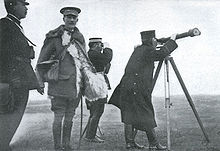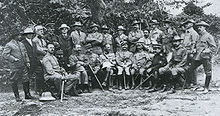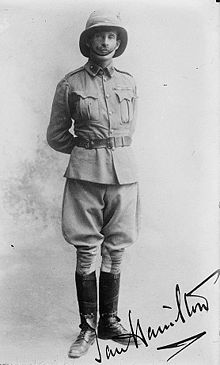Ian Standish Monteith Hamilton - Picture
More about World War 1

|
|
Ian Standish Monteith Hamilton
Sir Ian Standish Monteith Hamilton
Place of birth: Corfu,
United States of the Ionian Islands
Place of death: London, England
Allegiance: United Kingdom
Service/branch: British Army
Years of service: 1873-1915
Rank: General
Commands held: 1st Gordon Highlanders
Commandant, School of Musketry at Hythe
Colonel - 9th Royal Scots, 3rd Manchester Regiment, and the Queen's Own Cameron Highlanders
7th Brigade (South Africa)
Southern Command
Mediterranean Expeditionary Force
Battles/wars: Second Anglo-Afghan War
First Boer War
Mahdist War
North West Frontier skirmishes
Second Boer War
Russo-Japanese War
World War I (Battle of Gallipoli)
Awards: Knight Grand Cross of the Order of the Bath
Knight Grand Cross of the Order of St Michael and St George
Distinguished Service Order
Territorial Decoration
Order of the Red Eagle
Order of the Crown (Prussia)
Spanish Order of Merit
Order of the Sacred Treasure
Relations: (father) Colonel Christian Monteith Hamilton (mother) Corinna, daughter of the 3rd Viscount Gort
Other work: Aide-de-camp to Sir Frederick Roberts (1882-1893);
Military Secretary to C-in-C for India, Sir George Stuart White (1893-95)
Deputy Quartermaster-General, India (1895-1897)
Chief of Staff for Lord Kitchener (1899-1901)
Quartermaster-General (1903-05)
General Officer Commanding Southern Command (1905-09)
Adjutant-General of the Army (1909-10)
General Officer Commanding Mediterranean and Inspector-General of Overseas Forces (1910-1914)
Commander-in-Chief of Home Forces (1914-1915)
Lieutenant of the Tower (1918-20)
Rector of the University of Edinburgh (1932-35)
1st Gordon Highlanders
Commandant, School of Musketry at Hythe
Colonel - 9th Royal Scots, 3rd Manchester Regiment, and the Queen's Own Cameron Highlanders
7th Brigade (South Africa)
Southern Command
Second Anglo-Afghan War
First Boer War
Mahdist War
North West Frontier skirmishes
Second Boer War
Russo-Japanese War
Knight Grand Cross of the Order of the Bath
Knight Grand Cross of the Order of St Michael and St George
Distinguished Service Order
Territorial Decoration
Order of the Red Eagle
Order of the Crown (Prussia)
Spanish Order of Merit

Picture - Gen. Sir Ian Hamilton (facing front) with Japanese General Kuroki Tamemoto after the Japanese victory in Battle of Shaho (1904).
General Sir Ian Standish Monteith Hamilton GCB GCMG DSO TD (16 January 1853 - 12 October 1947) was a general in the British Army and is most notably for commanding the ill-fated Mediterranean Expeditionary Force during the Battle of Gallipoli.
Biography
Hamilton was politically a Liberal. He spoke German, French and Hindi, was considered charming, courtly and kind. He appeared frail, yet was full of energy. He was twice recommended for the Victoria Cross, but on the first occasion was considered too young, and on the second too senior. He was wounded in the wrist in the First Boer War (1881) at the Battle of Majuba, leaving his left hand almost useless. His left leg was shorter than the right, as a result of a serious injury falling from a horse.
Different people came to hold differing opinions of him. Prime minister Herbert Asquith remarked that he had 'too much feather in his brain', whereas Charles Bean, war correspondent covering the Gallipoli campaign considered he had 'a breadth of mind which the army in general does not possess'. He opposed conscription and was considered less ruthless than other successful generals.
He wrote a volume of poetry and a novel contemporarily described as risqué. Works included The fighting of the future, Icarus, A jaunt on a junk, A Ballad of Hadji and A Staff officer's Scrapbook. Writing in the introduction of his Gallipoli Diary, he commented: There is nothing certain about war except that one side won't win.
Hamilton's father was Colonel Christian Monteith Hamilton, former commander of the 92nd Highlanders. His mother Corinna was the daughter of the 3rd Viscount Gort. His mother died giving birth to his brother, Vereker. He was educated in Cheam, Surrey and then at Wellington college. His father then sent him to stay with General von Damimers, a Hanoverian who had fought against Prussia. He married Jean Muir in 1887, daughter of a Glasgow businessman.
Hamilton was filmed as part of a war documentary 'Forgotten Men' in 1934 (aged 81).
Military career
Hamilton attended Royal Military Academy Sandhurst in 1870, the first year that entrance to the army was by examination rather than by purchasing a commission. In 1871 he joined the Suffolk regiment but shortly after transferred to the second battalion Gordon Highlanders stationed in India, taking part in the Afghan War.
In the First Boer War he was present at the battle of Majuba, where he was injured and then taken prisoner. He returned to England to recover, where he was treated as a hero and introduced to Queen Victoria. In 1882 he was made captain and took part in the Nile expedition of 1884-1885, becoming brevet major. In Burma 1886-1887 he became Brevet Lieutenant Colonel. In Bengal from 1890-1893 he became Colonel in 1891 together with a Distinguished Service Order. 1893-1895 part of Chitral Expedition as military secretary to Sir George Stuart White, commander in chief of forces in India. 1895-1898 Deputy Quarter Master General in India. 1897-1898 commanded the third brigade in the Tirah Campaign, where his left arm was injured by a shell.
In the Second Boer War he was attached to the Natal Field Force as acting adjutant general and commanded the infantry at the Battle of Elandslaagte. He took part in the Battle of Wagon Hill at Ladysmith and was frequently mentioned in despatches. He was knighted in 1902, was promoted major general, received a Knight Commander of the Order of the Bath and became Chief of Staff to Lord Kitchener. The war correspondent Winston Churchill told of his campaign from Bloemfontein to Pretoria in Ian Hamilton's March (London, 1900, reprinted as the second half of The Boer War), having first met Hamilton in 1897 when they sailed on the same ship. Hamilton travelled 400 miles from Bloemfontein to Pretoria fighting 10 major battles with Boer forces (including the battle of Rooiwal) and fourteen minor ones, and was recommended twice for the Victoria Cross (which was considered inappropriate because of his rank).

Picture - Western military attachés and war correspondents with the Japanese forces after the Battle of Shaho (1904): 1. Robert Collins; 2. David Fraser; 3. Capt. Francois Dhani; 4. Capt. James Jardine; 5. Frederick McKenzie; 6. Edward Knight; 7. Charles Victor-Thomas; 8. Oscar Davis; 9. William Maxwell; 10. Robert MacHugh; 11. William Dinwiddie; 12. Frederick Palmer; 13. Capt. Berkeley Vincent; 14. John Bass; 15. Martin Donohoe; 16. Capt. ____; 17. Capt. Carl von Hoffman; 18. ____; 19. ____; 20. ____; 21. Gen. Sir Ian Hamilton; 22. ____; 23. ____; 24. ____; 25. ____.
In 1901 to 1903 he was Military Secretary at the War Office and in 1903 to 1904 he was Quartermaster-General to the Forces. In 1904 to 1905, Hamilton was the military attaché of the Indian Army serving with the Japanese army in Manchuria during the Russo-Japanese War. Amongst the several military attachés from Western countries, he was the first to arrive in Japan after the start of the war.
This military confrontation between a well-known European army and a less-familiar Asian army was the first time the tactics of entrenched positions for infantry were defended with machine guns and artillery. This was the first twentieth century war in which the technology of warfare became increasingly important, factors which came to dominate the evolution of warfare during World War I.
Hamilton wrote that cavalry was obsolete in such a conflict, though many cavalry forces were deployed in World War I by the British army. He became a supporter of non-traditional tactics such as night attacks, and the use of aircraft.
Hamilton went on to serve as General Officer Commanding Southern Command between 1905 and 1909 and as Adjutant-General to the Forces between 1909 and 1910.
The Dardanelles
Kitchener appointed Hamilton to command the Allied Mediterranean Expeditionary Force to gain control of the Dardanelles straits from Turkey and capture Constantinople in March 1915. Hamilton was 62 and had been in charge of Land defenses for England. Whilst a senior and respected officer, perhaps more experienced in different campaigns than most, he was considered too unconventional, too intellectual and too friendly with politicians to be given a command on the western front. Hamilton was not given a chance to take part in planning the campaign. Intelligence reports were poor and grossly underestimated the strength of defending forces and their willingness to fight. It was conceived that a force of 70,000 men would be adequate to rapidly overpower the defenders.
The plan to take control of the Dardanelles and open a new front in the war had been considered in various forms in 1914. In November that year, British ships shelled the outer forts, causing the magazine at Seddx¼lbahir castle to explode. In December, a submarine entered the channel and attacked a Turkish battleship, x‡annakkale. Both these events raised the hopes of the British that an easy victory might be had, but as a consequence the Turks set about laying mines through the channels to prevent ships approaching and strengthened the fortifications. On 3 January 1915 First Sea Lord, Admiral Fisher presented a plan to the War council for a joint naval and military attack, using 75,000 troops, but only if the attack could be launched immediately. By 21 January, he wrote privately to Admiral Jellicoe that he could not approve the plan unless 200,000 men were available. Churchill himself, as First Lord of the Admiralty, had initially suggested in September 1914 that the support of 50,000 men would be needed.
An attempt was made commencing 19 February to take the strait using naval power alone. For the large ships to approach and shell the forts, the mines had to be cleared. The mines could not be cleared because of inadequate minesweepers, and the ongoing shell fire from the forts. The plan had been conceived with the idea of only sending second-rate ships which were considered expendable. On 18 March the British and a squadron of French ships mounted a more determined attack, with the result that three were sunk and three disabled by undiscovered mines. There was little effect on the defenders, except to cause them to expend the majority of their ammunition. Churchill ordered admiral John de Robeck to continue the operation, but De Robeck, replacing the intended commander of the fleet, Admiral Sackville Carden (who had become ill) saw no sense in losing further ships, and withdrew. It was then decided that an invasion by troops would be required. Had the bombardment continued it is likely the defending guns would have ceased firing for lack of shells, the minesweepers could have worked effectively and the British ships could have moved in to their objectives. .

Picture - General Hamilton in a formal pose (1910).
Hamilton became responsible for organising armed landings. He had no specialised landing craft, the disparate troops he had been given had no training, and supplies for the army had been packed in ways which made them difficult to access for landings. Hamilton believed that the navy would make further attacks during his landings. The navy, realising likely losses and fundamentally opposing the idea that tactical losses of ships was acceptable declined to mount another attack. The Turks had been allowed two months warning from the first serious navy attack to prepare ground defences before the follow-up ground landing could be mounted, and they used the time effectively.
Following the failure of the Dardanelles expedition, Hamilton was recalled to London on 16 October 1915, effectively ending his military career.
Later life
In retirement, Hamilton was a leading figure in the ex-servicemen organization, the British Legion holding the position of Scottish President.
Hamilton was also a founding member and vice-president of the Anglo-German Association in 1928 which promoted pro-German sentiment in Britain. Hamilton remained with the Association after Adolf Hitler's rise to power and described himself as "an admirer of the great Adolph [sic] Hitler", dismissing Mein Kampf as a youthful excess.
Hamilton also expressed anti-Semitic sentiments and supported a proposed ban by the Association on Jewish members-the ban was not implemented, instead the Association dissolved on 2 April 1935 in light of the worsening situation in Germany.
Selected works
Hamilton's's published writings encompass 83 works in 168 publications in 8 languages and 2,998 library holdings.
This is an incomplete list, which may never be able to satisfy particular standards for completeness. You can help by expanding it with reliably sourced entries.
1887 - The ballad of Hx¡dji, and Other Poems
1905 - A Staff officer’s Scrap-book during the Russo-Japanese War, Vol. I.
1907 - A Staff officer’s Scrap-book during the Russo-Japanese War, Vol. II. London: E. Arnold; New York: Longmans, Green. OCLC 10080215
1910 - Compulsory Service; a Study of the Question in the Light of Experience
1915 - Sir Ian Hamilton's Despatches from the Dardanelles, etc.
1919 - The Millennium
1920 - Gallipoli Diary. New York: G.H. Doran. OCLC 580456.
1921 - The Soul and Body of an Army
1923 - The Friends of England; Lectures to Members of the British Legion
1926 - Now and Then
1939 - When I was a Boy
1944 - Listening for the Drums
1957 - The Commander
Military attachés and observers in the Russo-Japanese War
Carlyon, Les A. (2002). Gallipoli. New York: Pan Macmillan. 10-ISBN 0-7329-1128-1; 13-ISBN 978-0-7329-1128-7
Jenkins, Roy. (2001). Churchill: A Biography. New York: Macmillan Publishers. 10-ISBN 0-452-28352-3; 13-ISBN 978-0-452-28352-7
Kershaw, Ian. (2004). Making Friends with Hitler: Lord Londonderry and the British Road to War. London: Allen Lane, 10-ISBN 0-7139-9717-6; 13-ISBN 978-0-7139-9717-0
More aircraft.
Source: WikiPedia